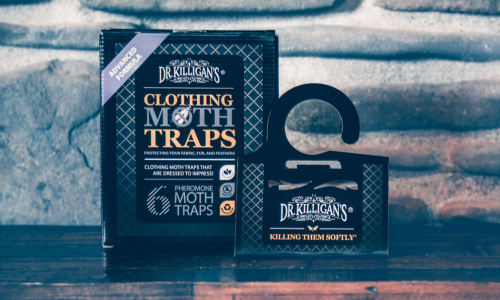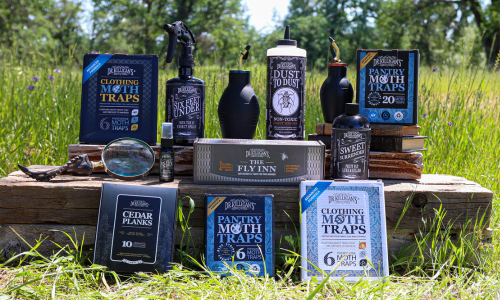Clothing moths are not bound by state lines, countries, or even continents. They will happily infest any wardrobe, regardless of whether these clothes are tucked away in a suitcase, hanging in a closet, or folded in your dresser drawers.
They do, though, have their preferences. They like crowded cities, as people-congested metropolises offer exactly what these moths need to dine, wine, and climb to large numbers (breeding). Clothing moths literally want the clothes on your back.
The question that you’re now posing is "Am I living in a moth-infested city"? If you’re living somewhere that’s densely populated, then the answer is yes, even if your city doesn’t appear on our top cities list.
Clothing moths are making headlines in California, New York, and Massachusetts. They’re also prevalent in Texas, where about 4,700 species of moth have already been recognized. In Virginia, they are one of the most prevalent moth types, along with the brown house moth and Indian meal moth. Florida boasts an ideal clothing moth temperature, especially South Florida. Clothing moths prefer dark, warm, and humid spaces. This is pretty much South Florida year-round.
Is the population of clothing moths increasing?
Clothing moths are reportedly on the rise around the world. In addition to this, we are surely becoming more aware of their presence. If, during the COVID pandemic, you turned the key in its lock and left your home for a while, your pest population that may (or may not) have been there was suddenly set free, free to reign, to eat, to drink, and to be quite merry. (The offspring-producing females can lay up to 50 eggs during their shorter-than-a-year lifetime.)

This suddenly-set-free population caused an uptick in Dr. Killigan’s Clothing Moth Trap orders. You should not be surprised. We at Dr. Killigan’s have the most clothing moth trap orders from California, followed by New York, Massachusetts and Pennsylvania.
What is unique is that clothing moth larvae, unlike other caterpillar pests, are beginning to adapt to living alongside humans within urban and suburban environments. Perhaps they are on their way to stardom, becoming a winged fabric-destroying pest fixture in human-inhabited environments? In their adaptation, there has been an increase of their presence in many metropolitan areas of the U.S., particularly Los Angeles, New York, City, and Boston, along with other highly populated areas, as clothing moths can travel from residence to residence more easily in densely populated cities. Subsequently, there has been a decrease of their livelihood in more rural areas.
What’s unfortunate is that clothing moths are hitchhikers, spread by catching a lift on that used cashmere sweater, that worn and loved plush leather sofa, or that massive wool rug that you just bought for a song from an antique dealer. In fact, they can even spread from person to person. Are you and your friend both wearing wool sweaters? Beware of the potential consequences.
Clothing moths are curious in this sense. Most insect species gain a foothold through travel indoors from their natural habitat. Most insects, though, do not eat clothes.
Are clothing moth issues worse in apartments?
Large apartment buildings are considered the most "at-risk" dwellings for clothing moths (in addition to a number of other creepy crawlers), as these winged invaders can easily spread from one infested unit to another. A single resident that ignores a growing issue in their own apartment inevitably causes a growing issue for its neighbors. There are no boundaries or invisible fence lines that clothing moths will not cross.
Depending on the design of the building, a moth may simply commute through pipe chases or ventilation duct-work from one unit to the next. They may also flitter from one open window to the next, crawl through cracks and crevices around a baseboard and in your walls, or even fly-hop from one person wearing a silk shirt to another. They can get into the apartment above you, below you, or beside you. You might be the unfortunate tenant of one of those neighboring apartments. Do what you can to prevent an infestation.
Why are there greater clothing moth issues?
Don’t abandon your apartment, but don't stay for long periods inside of your apartment either. Sound confusing? There may have been confusion among us as to the best plan of action during the pandemic, but the clothing moths were not befuddled. They were on a mission and in many ways they succeeded (at least temporarily).

If you abandoned your apartment (or house or condo) for a season, you may have come home to find a party going on, in which you were clearly not invited to (and definitely weren’t wanted). It was a party for pests and pests alone.
If you didn't leave your apartment, until desperation for toilet paper overtook you, you may have begun to notice clues of clothing moth activity that you had not seen before. Were the fringes of that rug always damaged? Why, when I lifted the lid on my piano (for the first time in a short eternity), I saw that the felt linings on the interior string hammers were destroyed? What are those cigar-like cocoons on the undersides of the cushions on my leather couch that sits in the front parlor (for decoration and not for bodies)? Why did it look like my fur coat was shedding when I pulled it out from the dark recesses of my closet? Finding yourself home a lot, you start detecting a lot. You begin to wonder if you have the necessary qualifications for a detective.
In addition to not abandoning your place of safety and comfort (but not staying too long in your abode either), if, during covid-19, you redecorated or renovated your apartment, home, condo, or hammock, depending on where you live, you may have unearthed a dormant moth problem. Clothing moths like to hide out in those preserved animals that you just gingerly moved, in your beautiful antique dolls with real hair that once sat in a cabinet in your living room, or in your heavy horsehair-stuffed ottoman.
If you made a temporary move and then came back to a quiet, dark, still, and ideal-temperature home, having set the thermostat at 65 before you left, you’re bound to find that someone moved in, even if just a spider. (We have our kill-on-contact Six Feet Under Non-Toxic Insect Spray for that issue.) Your clothing sat still. It most likely hung from its hangers in the dark. No one was there to shuffle around in the back of your drawers. There was no air-flow. You weren’t there to cycle through your garments; thus, some small bug decided it would nest in your garments.
It all started with that one piece that was put away in the dark...
Why should I purchase a trap today?
Don’t be like the shoemaker whose children have holes in their shoes. Prioritize the purchase of Dr. Killigan’s Clothing Moth Traps before it's too late. The good news: Our traps, unopened, are good for three years from the date of manufacture. That gives you three years of protection, just in case. How can it not be worth it?
How do I get rid Of clothing moths? Are there other preventative measures I should take?

- Purchase Dr. Killigan’s Insect Buster and fill it with Dust to Dust, a superb alternative to diatomaceous earth, that is proven to have kill times up to 50% faster. Disperse this into any and all cracks and crevices.
- Ensure that you have clothing moths (and not pantry moths).
- Become knowledgeable about the various types of moths that will invade your home.
- Familiarize yourself with what clothing moths eat.
- Take out, shake, and wear all of your clothes. This is the easiest trick for moth determent.
- Eliminate a moth’s food source. Keep clothing that you don’t wear frequently in sealed clothing bags. If storing for a long period of time, I recommend vacuum-sealed plastic bags.
- Vacuum and regularly clean all keratin-rich items that moths will infest (that aren’t stored).
- Consider having your wool carpets or rugs professionally cleaned twice a year. In the meantime, lift furniture and vacuum every square inch of these carpets and rugs.
- Wash your clothes regularly. Moths are abuzz with the smell of urine, sweat, and food stains.
- Purchase a freezer just for your sweaters. Name it your "sweater freezer."
If you’re feeling overwhelmed, need expert advice, need someone to walk you through the steps of how to get rid of your clothing moths, or are just generally concerned about clothing moths, give us a call. We can be reached at 844-525-2779. If you prefer to email us, you can do so at support@drkilligans.com. We look forward to hearing from you.










